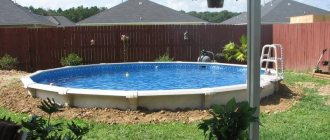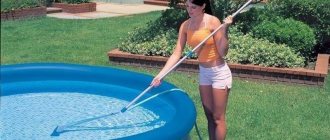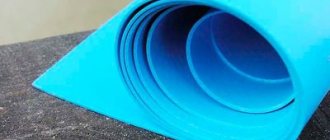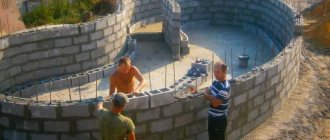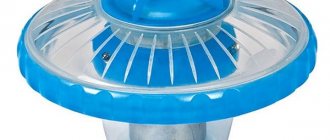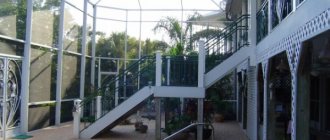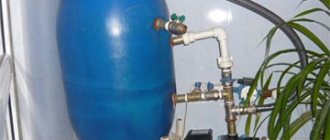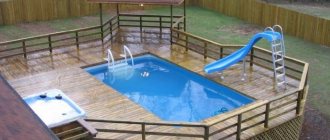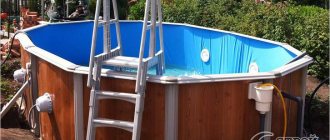Why have a pool at home?
A huge swimming pool in a private house speaks of the owner’s financial well-being, his concern for health, and his active lifestyle. Even without leaving your own yard, you can spend your free time with health benefits. The reservoir opens up a lot of possibilities:
- Now you can not just take a bath or shower, but swim fully.
- Swimming is available at any time of the year, regardless of the weather outside.
- A home pool located inside a building is much easier to maintain. Costs are minimal.
- The design of an internal reservoir does not require any special refinements. For such a pool, the design can be simple and concise, and the color scheme can be neutral. You can use 1-2 bright accents that will lift your spirits. After all, the main task of an artificial reservoir is the opportunity to fully swim at home and relax properly.
It's always great to have a huge pool at home
Filtration system
The main filtration systems are:
- Skimmer
- Overflow
The choice of system directly depends on the shape of the pool.
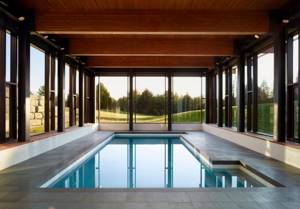
Indoor pool in the house
Skimmer water purification system
If you have a rectangular pool, then a skimmer filtration system is suitable. The essence of this filtration is that a device called a skimmer collects the top layer of water, which is the dirtiest. And through the holes in the walls of the pool, clean, disinfected water is supplied.
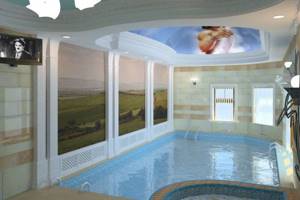
Small swimming pool in a private house
Overflow cleaning system
A distinctive feature of overflow pools is that the edge of the water is level with the side; accordingly, it is displaced by clean water coming from the bottom and poured into specially designated gutters.
To successfully build a pool, you will need a well-designed project. Therefore, do not neglect the help of specialists. In addition to the basic rules of construction and external characteristics, there are a lot of nuances that need to be taken into account. Specialists will help you with architecture, design of the pool bowl, as well as with the supply of all necessary communications.
Take on the responsibility of monitoring the quality of materials needed for construction. Since the main problem that most often arises during the operation of a swimming pool is a violation of the tightness. This way, you can protect yourself from premature pool repair work.
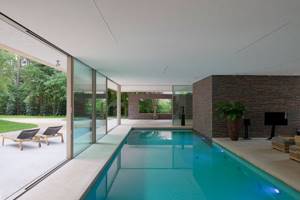
Design option for a house with a swimming pool
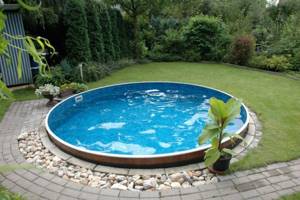
Small round pool on site
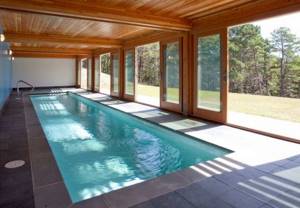
Long indoor pool
Varieties
Pools installed inside a private home are called indoor pools. The design of such a pool is no different from an outdoor pond. The bowl is made directly on site or in the factory. In the first case, monolithic technology is used - the bowl is made of concrete.
An alternative option is reinforced concrete structures that are quickly assembled, steel sheets. The structure is reinforced with cement screed.
The main difference between a pool in the basement and a reservoir located in an open area is this. In order for the internal structure to function fully, the arrangement of technical communications is mandatory.
It is impossible to imagine the construction of an indoor pool without the following components:
- Water supply system.
- Ventilation.
- Heating, electricity supply.
Water discharge and a drainage system are recommended as additional options. After installing the above systems, the load on the electrical grid will increase. It is possible that powerful equipment will have to be installed. Some homeowners even install their own substation. Designing a swimming pool in a private house is much more difficult. It is recommended to resolve the issue of constructing a reservoir at the stage of housing construction.
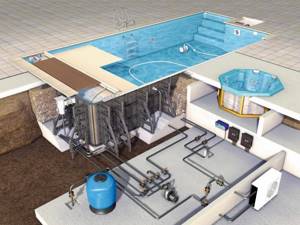
Pool layout on the ground floor
You will always have the opportunity to improve and modernize the standard design of the pool by installing water options. This could be everyone’s favorite jacuzzi and hydromassage, wave acceleration, various slides, and trampolines.
Inside the house or outside
First of all, you need to decide where the font will be located: within the walls of the house or just on the site. Each of these options has its advantages, but indoor and outdoor pools also have disadvantages.
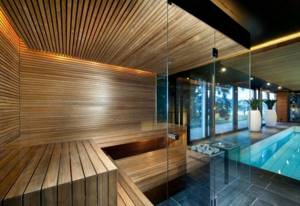
So, the advantages of an indoor pool in the house are as follows:
- you can use it all year round;
- swimming time is not limited by weather conditions “overboard”;
- you will have to take care not only of heating the room itself, but also of heating the water;
- the water in the house practically does not become clogged, so it will have to be changed much less often than outside;
- next to the font you can organize a bathhouse or sauna;
- the design of an indoor pool can be more varied, since almost any materials can be used to implement it - atmospheric phenomena under the roof are not terrible;
- pumps, filters and other expensive equipment are located in the house, so they are less subject to wear and tear.
Attention! It is allowed to build an indoor pool only in the basement or on the first floor of the house. Raising this structure higher is unsafe; moreover, the implementation of such a project will be very difficult and expensive.
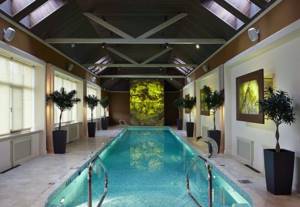
Unfortunately, the indoor pool also has some minor disadvantages:
- It is quite difficult to build it in a finished house; you will have to strengthen the foundation, additionally pour a concrete base, and install communications;
- such an idea is very difficult to implement on your own; most likely, you will have to involve professionals;
- the most important thing is that the indoor pool “eats up” an impressive part of the residential building, so it is suitable only for spacious mansions and villas.
Important! The undeniable advantage of a swimming pool inside a private house is the effectiveness of such a structure. Beautiful design, fashionable style, high-quality materials and blue clear water will do their job: a trace of what they saw will forever remain in the souls of the guests of the house.
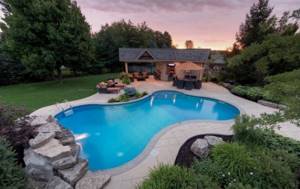
An open-air swimming pool is healthier, doctors say. It is clear that swimming in the fresh air, close to nature, is doubly pleasant. And yet, here you can have fun, dive and take a shower without worrying about the design of the room and interior decoration.
There are a couple more advantages:
- the water heats up on its own, under the rays of the sun (if desired, you can install an artificial heating system);
- near a bowl of clear water you can equip a wonderful relaxation area, with sun loungers, barbecue, gazebo, fountain and anything else;
- It’s cool near the water even in intense heat; the place by the pool will become a favorite place for relaxation;
- The cost of such a pleasure will most likely be cheaper, since it is easier to implement the idea of an outdoor pool than an indoor one.
A swimming pool in the backyard of a country house looks impressive; it completely changes the perception of the landscape and increases the status of the property.
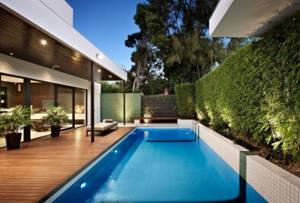
The design also has many disadvantages:
- limitation of design ideas - not all building materials can be used outdoors;
- the need to regularly clean water from leaves, branches, insects, street dust and other debris;
- seasonality of water treatments - swimming will only be possible in warm weather;
- the need to insulate systems or pump water out of the pool for the winter.
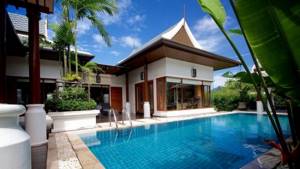
Advice! For those who are not afraid of problems and still want to install a swimming pool in the yard of their home, we can recommend building a canopy. The roof will protect the water from precipitation, debris, and create shade and coolness.
Subtleties of designing indoor pools
Arranging a swimming pool is another challenge. The first difficulties may arise when choosing a contractor. It’s good if there are companies in your city that offer all-inclusive installation. Typically, the range of such services for individual home ownership includes:
- Project development.
- Interior decoration.
- Installation of the bowl and additional equipment.
- Communications liner.
In small towns such services are very rare. You have 2 options: either cooperate with several contractors (some install a pool, others do communications), or look for general contractors in another region.
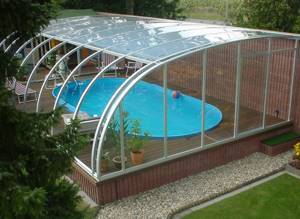
Indoor pool
When the issue with contractors has already been resolved, planning begins. During the first visit, the performers will calculate the volume and level of complexity. Professional workers always carry out a complex of geodetic studies. It allows you to determine the properties of the soil and the state of groundwater. The data obtained will allow you to understand what depth of the pool will be optimal in your case, in what place to place the bowl, what type to prefer, etc.
When it comes to installation in a finished building, a measurement plan of the premises will be drawn up. Several options will be proposed, and a recycling scheme will be developed. At this stage, pool ventilation is developed, control automation and filtration equipment are selected.
Also at the design stage, you can become familiar with the expected area of the water surface and the power of the systems used.
After approval of all plans, installation begins. Until the size, budget and other nuances are agreed upon, there is no point in starting work. At least, this is how professional installers carry out orders.
Type and shape
The most common size is 18 square meters. It allows you to comfortably float in length, and the rectangular shape easily fits into almost any landscape design.
Depending on the type of location, pools are:
- Not submersible. Installed above the ground line.
- Submersible - underground.
- Partially submersible. They are only half below the ground line.
A variety of materials can be used for manufacturing:
- The reinforced concrete form is made using reinforcement and heavy concrete.
- Polypropylene structures have many advantages. First of all, this is excellent tightness - you can forget about additional waterproofing.
- Brick. A clay brick is suitable; the wall thickness will be at least 25 centimeters.
- Collapsible - quickly assembled and disassembled. Based on plastic and metal.
The water supply also varies. The skimmer type has proven itself well in buildings erected separately. There are special recesses (skimmers) in the side walls. It is through them that water is taken for further filtration.
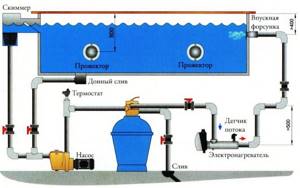
Scheme of water supply to the pool
With an overflow type of reservoir, the container is filled to the brim. The pool looks very bright. A gutter is placed around the perimeter - all overflowing water falls into it. From the gutter, the liquid enters the storage tank and is filtered. Overflow circulation is always more expensive due to design features.
Making a pool filter with your own hands
Sooner or later the water in the pool will become dirty, try making a filter yourself. The most affordable and easiest to manufacture is a sand filter.
To collect it, we need a container for sand; you can take an ordinary plastic container. Inside there is a device with which water is drawn.
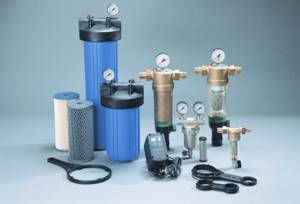
It is a drainage chamber, which is made of mesh, with a discharge pipe. Quartz or glass sand is poured inside. The service life of such a filter is 2-3 years.
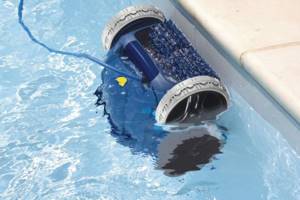
Overflow pond design
We have already talked about the impressive effect that overflow pools produce. There is a feeling of the limitlessness of the surrounding space. Another moment - and you can find yourself on the edge of the world. Such bathing will tone up any person. The effect is especially stunning when the building is on the edge of a hill and the apartment or hotel room is on one of the upper floors.
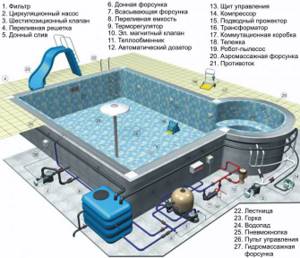
Overflow pool
If you have small children growing up in your home, an excellent option would be to install a pond with different depth levels. This is an additional guarantee of security. And if you make it overflow, the pool will turn out to be especially exciting. Such designs are not always due to the presence of children in the family. They are often dictated by the personal wishes and financial capabilities of the owners.
Creative ideas
If you are used to spending weekends outside the city and are the owner of a large cottage, the option of organizing a pond on the 1st floor will come in handy. Raising a huge volume of water to the second floor is not recommended for safety reasons. In addition, certain difficulties will arise when organizing the engineering system.
Recently, designers are increasingly turning to the oriental style and are successfully introducing overflow pool designs.
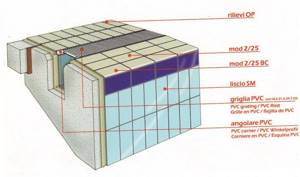
Overflow pool diagram
Preference is given to monochromatic finishing, minimalism (the fewer accessories, the better), and the presence of contrast (sharp transitions). This rule is especially relevant if your country house is equipped with a sauna. What could be better than refreshing coolness after a hot steam room? In addition, the contrasting temperature difference perfectly hardens the body. A person suffers from colds less often, and his immunity increases.
A creative solution would be to combine granite with warm wood tones of the walls. A good specialist can implement an idea.
Construction of an outdoor swimming pool
Many homeowners prefer artificial ponds located in open areas. Of course, swimming outdoors has its benefits. However, be prepared for the fact that an indoor pool does not need to be cleaned as often as an outdoor one. Branches, leaves, and small debris will constantly fall into it. You cannot do without preventive measures - in cold winters the water can freeze. The use of high-tech tools allows us to solve these problems.
Most often, outdoor pools are made in the shape of a rectangle. This is the simplest and most popular design option that will decorate any style of personal plot. Compared to more fancy sized pools, it is much easier to swim in. There will also be no problems with choosing the surroundings; it is not difficult to maintain symmetry. The geometry of the correct shape creates a feeling of comfort and practicality.
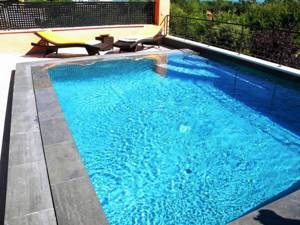
Outdoor infinity pool
What is the best way to organize the surrounding space? We recommend installing several sunbeds and trestle beds and comfortable sun loungers. After water treatments, you can sit comfortably on a sun lounger with a cup of tea or a soft drink. And if the weather permits, it’s also a great way to sunbathe.
An improvised deck made of wood easily turns into a dining area. Here you can receive guests. If wooden flooring does not suit you for some reason, there is always an alternative - stone tiles. You can't think of a better cladding option. It is recommended to use natural stone and concrete. The homeowner has the final say. Much depends on personal preferences and estimated budget. Externally, artificial materials and natural stone are not much different. But if we consider them from the point of view of reliability and strength, the undisputed leader is natural stone.
When the walls have a snow-white finish, for harmony it is worth taking the same sun loungers and light beige tiles. White marble is considered a truly universal material. It matches with almost any façade finish.
Stone
Sandstone and rubble can be used to finish the pool, but more often preference is given to:
- Granite. Such a stone will not fade and will easily tolerate temperature changes. In addition, it is very difficult to damage. Granite is waterproof and completely resistant to pool cleaning chemicals.
Healthy! Granite is considered the most durable stone on Earth.
- Marble. A completely environmentally friendly material that has antiseptic properties. Fungus and mold do not form on marble. It is easy to polish (marble is made up of grains of dolomite and calcite), so even if you manage to scratch it, it is an easy mistake to fix. In addition, it is believed that marble has healing properties and is an excellent stress reliever, so it will come in handy in the pool. But chemistry gradually destroys marble. Over time, too aggressive agents (for example, chlorine) may begin to turn into chalk. However, the problem can be solved with specialized means.
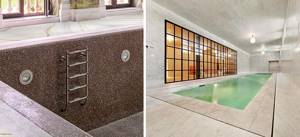
Healthy! When wet, marble becomes slippery, so it is best not to use it on the bottom of the pool, the area around it, or for stairs.
Laying the stone is done in the same way as in the case of tiles, using epoxy glue.
But natural stone also has disadvantages. For example,:
- High price. For example, to decorate a pool with marble, you need to be prepared for the fact that one slab (slab) can cost from 4,000 to 32,000 rubles. Granite will be cheaper, but will also hit your wallet hard.
- Difficulty in installation. The stone weighs quite a lot.
- It's easy to run into a fake. If they sell you only imitation marble instead of natural stone, it will be very difficult to recognize the forgery. Only a specialist can handle this. Granite is counterfeited less often.
